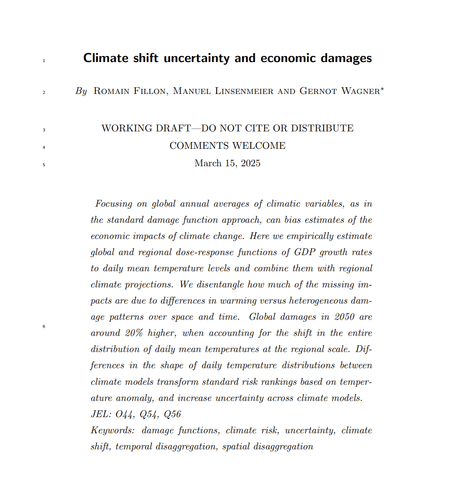Science: "US benefit-cost analysis requires revision"
Howard et al. (2023) Science 380 (6647).

Benefit-cost analysis should be guided by the best available data and methods. Yet when assessing regulations, US agencies currently value future impacts using outdated methods and data to determine discount rates. A proposal to revise a document known as Circular A-4 would address this deficiency by modernizing discounting guidance (1), which would substantially improve US regulatory analysis. A corresponding update has also been drafted for Circular A-94, which will improve US federal public investment analysis (2).
A social discount rate is used in benefit-cost analysis to translate impacts that occur at different times into comparable present values. Circular A-4, a US regulatory guidance document written in 2003 (3), directs agencies to use discount rates of 3% and 7% in most contexts. The 3% rate reflects the then-estimated risk-free rate at which society discounts consumption in the future. The 7% rate reflects the then-anticipated market rate of return to capital. These rates matter. For example, a hypothetical regulation might cost $20 billion today and yield $100 billion in undiscounted benefits in 30 years. Using the 7% discount rate, that $100 billion would be equivalent to $13 billion today. Regulators would compare the $20 billion investment with the $13 billion benefit and find a net loss of $7 billion. If a 3% rate is used instead, the same $20 billion investment, yielding the same $100 billion in 30 years, would be predicted to provide benefits equivalent to $41 billion today, a net gain of $21 billion. A lower discount rate thus provides agencies with more incentive to impose short-term costs to obtain long-term benefits such as environmental and health improvements.
Much has changed since 2003. Real returns to US Treasury notes—a common measure of the risk-free consumption rate—have trended lower, reflecting deep structural changes in the economy (4, 5). Recent economic literature strongly supports the use of a consumption discount rate over a capital rate of return over longer time horizons (6, 7) and shows that lower discount rates are appropriate for valuing long-term effects (8, 9).
Consistent with these principles, the US Office of Management and Budget’s (OMB’s) proposed update (1) uses more recent economic data to lower the consumption-based discount rate from 3% to close to 2%. It also ends the use of the 7% discount rate in regulatory analysis, replacing capital-based discount rates with a shadow price of capital approach that bounds the potential impacts of public interventions on capital (10). In addition, the update calls for a Ramsey framework that links discounting to economic growth and a declining rate over longer time horizons (11).
OMB could improve its update further by improving its discussion of risk. The draft focuses on risk-free discount rates and recommends modeling the insurance value of a policy with uncertain net benefits using certainty-equivalents (9). However, agencies may lack sufficient expertise to make such calculations. OMB should offer additional guidance on how to convert cash flows to certainty-equivalents, including how to specify preference parameters consistent with the risk-free rate (11). To ease agency burden, OMB should provide an approximation of the average social risk premium adjustment (similar to the approach used in the draft Circular A-94) for discounting expected net benefits. Similarly, OMB should provide guidance on relative prices in valuing environmental services (12).
The proposed Circular A-4 update is open for public comment until 6 June. Experts in the field should support the update and suggest further revisions. Economists should also continue to improve discounting theory, especially the assessment of capital displacement and augmentation, risk premiums, and realistic preferences.
Citation:
Howard, Peter H., Max Sarinsky, Michael Bauer, Caroline Cecot, Maureen Cropper, Moritz Drupp, Mark Freeman, Kenneth T. Gillingham, Christian Gollier, Ben Groom, Qingran Li, Michael Livermore, Richard Newell, William A. Pizer, Brian Prest, Glenn Rudebusch, Thomas Sterner, and Gernot Wagner. “US benefit-cost analysis requires revision.” Science 380 (6647). doi:10.1126/science.adi5943


